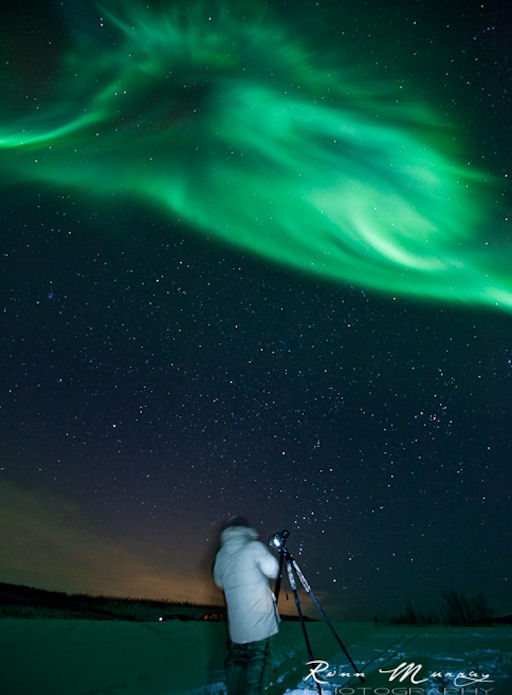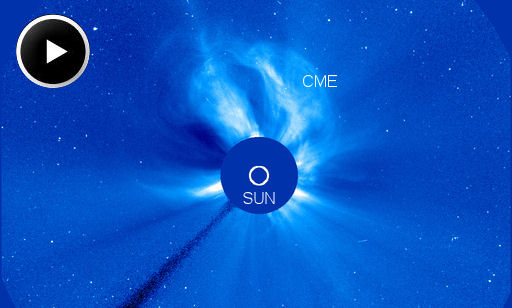WHILE WAITING FOR THE CME... An incoming CME of Jan. 19th (see below) has not yet arrived. Nevertheless, auroras are already dancing around the Arctic Circle. This was the scene last night over Chatanika, Alaska:
"My fellow Fairbanks aurora chaser, Roger Marty, is shown here shooting a corona as the display began to peak," says photographer Ronn Murray. "Perhaps we got a sneak peak of what's to come with tomorrow's expected CME from sunspot AR1401."
Indeed, it could be a preview. NOAA forecasters are estimating as much as a 25% chance of polar geomagnetic storms when the CME arrives during the next ~36 hours. High latitude sky watchers should remain alert for auroras. Aurora alerts: text, voice.
more images: from Frank Olsen of Tromsø, Norway
January 2012 Aurora Gallery
[previous Januaries: 2010, 2009, 2008, 2007, 2005, 2004]
INCOMING CME: Active sunspot 1401 erupted on Jan. 19th around 16:30 UT, producing an M3-class solar flare and a full-halo coronal mass ejection (CME). The Solar and Heliospheric Observatory recorded the cloud expanding almost directly toward Earth:
Analysts at the Goddard Space Weather Lab say strong geomagnetic storms are possible when the cloud arrives this weekend. Their animated forecast track predicts an impact on Jan. 21st at 22:30 UT (+/- 7 hrs).
The cloud is also heading for Mars, due to hit the Red Planet on Jan. 24th. NASA's Curiosity rover, en route to Mars now, is equipped to study solar storms and might be able to detect a change in the energetic particle environment when the CME passes by.
more images: from the Charlie Bates Solar Astronomy Project of Atlanta, GA; from Theo Ramakers of Social Circle, GA; from Jim Haklar of Edison, New Jersey; from Zach, Annissa, and Annie of The G.W. Hinckley School in Hinckley, Maine
![]()

![]()
Solar wind
speed: 316.0 km/sec
density: 4.9 protons/cm3
explanation | more data
Updated: Today at 1625 UT
![]()
X-ray Solar Flares
6-hr max: C2 1342 UT Jan21
24-hr: C2 1342 UT Jan21
explanation | more data
Updated: Today at: 1600 UT
![]()
![]()
![]()
Daily Sun: 20 Jan 12
![]()
![]()
Sunspot 1401 poses a continued threat for M-class solar flares. Credit: SDO/HMI
![]()
![]()
![]()
Sunspot number: 88
What is the sunspot number?
Updated 19 Jan 2012
Spotless Days
Current Stretch: 0 days
2012 total: 0 days (0%)
2011 total: 2 days (<1%)
2010 total: 51 days (14%)
2009 total: 260 days (71%)
Since 2004: 821 days
Typical Solar Min: 486 days
Updated 19 Jan 2012
The Radio Sun
10.7 cm flux: 157 sfu
explanation | more data
Updated 19 Jan 2012
![]()
![]()
![]()
Current Auroral Oval:
Switch to: Europe, USA, New Zealand, Antarctica
Credit: NOAA/POES
![]()
![]()
![]()
Planetary K-index
Now: Kp= 2 quiet
24-hr max: Kp= 2 quiet
explanation | more data
![]()
Interplanetary Mag. Field
Btotal: 10.3 nT
Bz: 0.7 nT north
explanation | more data
Updated: Today at 1627 UT
![]()
![]()
![]()
Coronal Holes: 20 Jan 12
![]()
![]()
There are no large coronal holes on the Earthside of the sun. Credit: SDO/AIA






